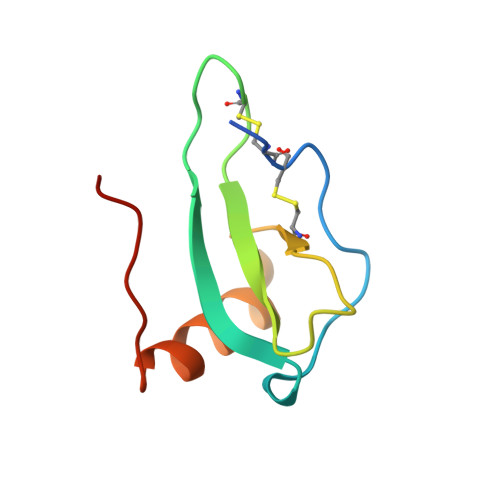Crystallographic Structure of Truncated CCL21 and the Putative Sulfotyrosine-Binding Site.
Smith, E.W., Lewandowski, E.M., Moussouras, N.A., Kroeck, K.G., Volkman, B.F., Veldkamp, C.T., Chen, Y.(2016) Biochemistry 55: 5746-5753
- PubMed: 27617343
- DOI: https://doi.org/10.1021/acs.biochem.6b00304
- Primary Citation of Related Structures:
5EKI - PubMed Abstract:
CCL21 chemokine binds the G protein-coupled receptor CCR7, aiding not only in immune response but also in cancer metastasis. Compared with other chemokines, CCL21 has a unique extended unstructured C-terminus that is truncated in some naturally occurring variants. We have determined the X-ray crystallographic structure of a truncated CCL21 (residues 1-79) lacking the extended C-terminus and identified, via two-dimensional nuclear magnetic resonance (NMR), a putative sulfotyrosine-binding site that may recognize such post-translationally modified tyrosine residues on the receptor. Compared to the previously determined NMR structure of full-length CCL21, the crystal structure presents new druggable binding hot spots resulting from an alternative N-loop conformation. In addition, whereas the previous NMR structure did not provide any structural information after residue 70, the C-terminus of the truncated CCL21, ordered up to Ala77 in our crystal structure, is placed near the N-loop and sulfotyrosine-binding site, indicating that the extended C-terminus of full-length CCL21 can interact with this important region for receptor binding. These observations suggest a potential origin for the autoinhibition of CCL21 activity that was recently described. The new crystal structure and binding hot spot analysis have important implications for the function of the CCL21 C-terminus and drug discovery.
- Department of Molecular Medicine, University of South Florida , Tampa, Florida 33612, United States.
Organizational Affiliation:

















